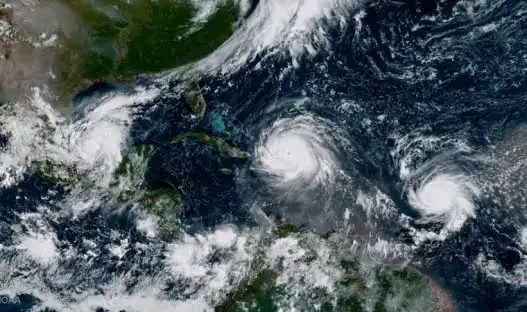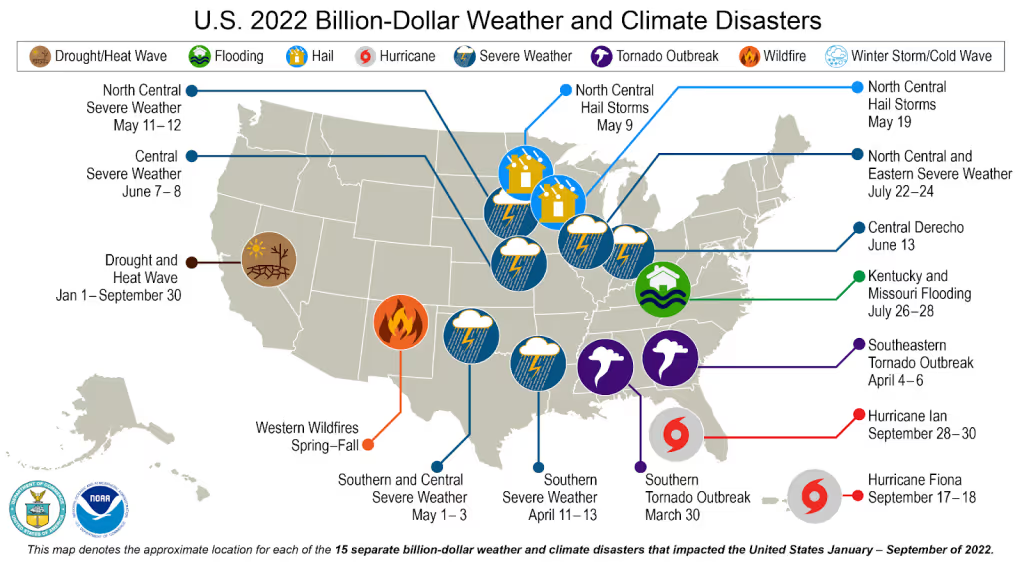
by Betsy Weatherhead and Pat Harr
Science Fellows
Jupiter Intelligence
In November, COP27, the United Nations’ climate summit summarized 2022 natural disasters and their costs. As extreme weather events become more common due to climate change, the costs and loss of human life continue to rise.
According to a December, 2022 Bloomberg article, the Swiss Re Institute’s annual analysis, which looks at losses from natural catastrophes such as floods, hurricanes and wildfires, estimated the total economic losses around the world would reach $260 billion in 2022 and have had a major impact on loss of human life.
Below are some of the major severe weather and climate change-related events of 2022 and their impact:
- Brazil’s floods killed at least 233 people in February, and a massive drought across the country impacted crop production, resulting in $4B in losses.
- Europe’s Storm Eunice resulted in 16 deaths and $4.3B in damages in February.
- South African flooding resulted in 461 deaths and $3B in damages in April.
- Tropical Storm Megi killed 214 people in the Philippines in April.
- An Earthquake in Afghanistan killed at least 1,036 people in June.
- Flooding in India took 192 Lives from June to September.
- China’s floods totaled $12.3B in damages from June to September.
- A European drought brought scorching temperatures, resulting in 3,271 deaths and $20B in costs from June to September.
- Fires across Europe ravaged nearly 660,000 hectares (1,630,000 acres) of land between January 1 and August 13.
- The Mosquito Fire was a large wildfire that burned 76,788 acres in California resulting in $181M in suppressed costs.
- Pakistan floods killed at least 1,739 people and resulted in $5.6B in damages from June to October.
- Floods in Nigeria took 612 lives from June to November.
- An East Africa Drought killed at least 200 people in July.
- Hurricane Ian in the U.S. comes in at the most expensive climate-related disaster of 2022 with losses and damages worth $100B in September.
And while these tragedies garner significant attention, there are other, less discussed events that have an enormous impact on millions of people and in the billions of dollars – including climate change-induced chronic events.
Why the increase?
The billion-dollar disasters and their accompanying loss of life stem from a combination of a changing climate and more infrastructure and people. The observed events are a mix of both acute and chronic extreme events.
Acute events occur rapidly, result in significant loss at specific locations and are linked – sometimes inconsistently – to global rising temperatures. According to NOAA, in the U.S. alone, there were 15 separate billion-dollar weather and climate related acute events from January to September.

Chronic events evolve gradually over large spatial regions, and are very consistent with rising global temperatures. For example, the fifth hottest year on record has been announced from multiple analytical centers around the world (WMO, NOAA, and NASA) based on their own analyses.
Chronic events also have the potential for significant global impact on human health and well being, transportation and distribution, food supply, security, energy production, and natural ecosystems. According to Reuters, the floods in Pakistan (acute events) that killed over 1,500 people were a result of melting glaciers (a chronic event) that contributed to the overall intensity of the flooding. This impacted 33 million people out of a population of 220 million, sweeping away homes, vehicles, crops, and livestock and damages estimated in the billions of dollars.
Where are these events occurring?
2022’s global chronic climate-induced impacts were significant as shifting weather patterns brought drought and heat to west, south and central Europe while parts of northern and eastern Europe experienced large-scale flooding.
Almost all of the observed extreme events occurred in areas known to be at risk of these types of perils. For example, droughts are continuing in areas that have historically experienced drought. However, recent events are more severe, longer lasting and more impactful because of climate change. For highly localized events such as floods, the locations for flooding can be highly specific with some neighborhoods being hit particularly hard, while others are left unscathed. Impacts can vary even from block to block.
Hopeful Developments on the Horizon
There is a bright side to the evolving climate risk story. Renewable energy continues to grow and prove itself a significant source of energy. Public interest in clear air and a carbon-free future is pushing toward more sustainable approaches to energy consumption.
Organizations around the world are starting to embrace technology to predict these events and take steps to adapt and build resiliency. This is where Jupiter is making its mark and helping.
Leveraging Technology and Taking Action
Jupiter is on a mission to help the business community understand and address the impact of climate change by being the global standard for understanding risks from severe weather and climate change. And we are fulfilling that mission with our best-in-science, software-as-a-service (SaaS) technology, ClimateScore Global, and its ability to identify locations at risk today and in the future.
Jupiter’s ClimateScore™ Global can quantify physical climate risk from any peril anywhere on the planet at high resolution globally. ClimateScore Global’s scope and granularity captures the most complete view of climate risk across the globe and across time.
Professionals from multiple industries can project how a portfolio of assets may be affected by climate change; including the perils it will be exposed to, the vulnerable segments and locations and how that risk will change over time and across varying carbon emissions scenarios.
With this knowledge, organizations around the globe can incorporate climate risk into their overall enterprise risk management strategies and use it to respond to increasing inquiries from regulators and shareholders.
Learn more or request a demo and don’t forget to follow us on LinkedIn.
Betsy Weatherhead is a Science Fellow and The Jupiter Promise Lead at Jupiter.
Pat Harr is a Science Fellow at Jupiter.
Jupiter Intelligence is the global leader in climate analytics for resilience and risk management. For further information, please contact us at info@jupiterintel.com.
.webp)
